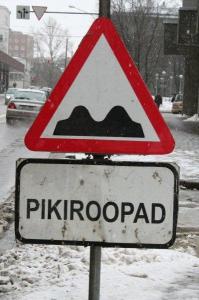
Most of Estonia was still covered in snow and ice in late March, although the sun was doing it's thing by day, causing meltwater to fill up pikiroopad, including on this section of Kreutzwaldi tänav at the intersection of Gonsiori in Tallinn. What on earth?... Photo: Riina Kindlam
The reason they are prohibited in many locales is quite evident on sections of road in Eesti, where studded winter tires (as well as heavy vehicles on poorly patched ruts) have literally worn trenches, locally nicknamed kartulivaod or potato furrows, in the pavement. At pedestrian crosswalks you can feel the undulations underfoot and when they fill with water – beware pedestrians and drivers alike.
Yet it's hard to convince those who put their faith in the little metal studs, which first took off in popularity in Scandinavia in the 1950s, to give them up. In Estonia, winter tires (talverehvid, -kummid), including all-season (lamellkummid), not studded tires, are mandatory from October through March. Yet almost 80% of Estonian drivers choose the latter. The greatest advantage of the studs is that they have been proven to double adhesion in cases of kiilasjää (sheet ice) and must jää (black ice). They also roughen up the ice, thereby providing better traction for everyone else on road.
Vello Mespak, road engineer at Tallinn Technical University has calculated that one year's road wear in downtown Tallinn (given increased wear by heavy vehicles, on wet pavement and in higher traffic areas) could equal 14-35 mm a year. It has been suggested Estonia's road repairs, resembling a lapitekk or patchwork quilt, could be slowed by using a more durable asphalt mix. It's a matter of determining the weakest link, as well as a matter of funds and moreover – safety. But how often do perfect, lifesaving naelkummi conditions occur in our ever-warming climate? According to the Department of Transportation in the state of Washington, where the battle to ban the sale and use of studded snow tires in currently raging, drivers encounter those relatively rare driving conditions (i.e. sheet ice) about 1 percent of the time. Spokane senator Chris Marr says "an estimated $18.2 million a year could be saved in state road damage from metal tire studs hammering away at concrete pavement". In recent years, lawmakers there have repeatedly proposed a $15 fee on each studded tire, as well as shortening the five-month use period to three months. All those efforts failed.
With the sole exception of Ontario, studs are allowed throughout Canada during winter, with the exact period varying from province to province. Some who swear by them believe the Ontario ban seems to have given studded tires an undeserved bad reputation right across the country. An anonymous driver who knows a true Canadian winter comments online: "I live in Manitoba and install them on my old F150 every fall and remove them every spring. That, along with 2 sand bags in the back corners of the box, have prevented me from getting stuck in all road conditions." Amen.
Print issue correction: The photo of pikiroopad appeared in the March 27 issue of Estonian Life with an incorrect caption and without its accompanying article. The article was published in the following, April 3 issue. Regretfully these should have appeared together.
Advertisement / Reklaam
Advertisement / Reklaam

